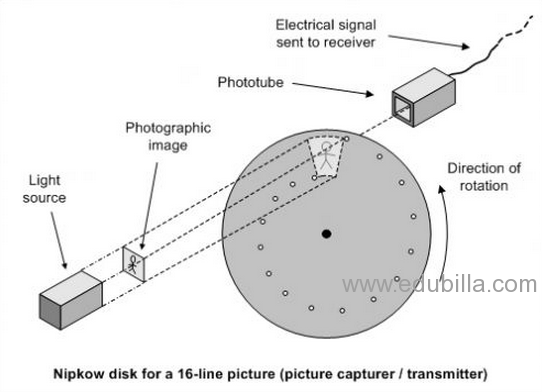Television! One of the most influential of the broadcast mediums. Its power has lasted for decades and has played an influential role in the expansion and development of what we call popular culture (pop culture). The process by which this medium has evolved to its modern-day standard was an intricate journey that shall be explored.
Television ‘began’ in 1926 John Logie Baird demonstrated television in London. In the form of televised silhouette images. However, as all inventions go there were significant technological inventions necessary to reach this point.
First, we begin with Paul Nipkow. In 1884 he introduced the concept of the Nipkow disk, which was a mechanical system that created a scanning effect when used with a beam of light. The disk had a spiral of holes bored into it. When the disk rotated, the holes would sweep over the whole image from top to bottom, slicing the image into 18 columns of information. Behind the disk were selenium photocells, which reacted to the light passing through the disk. The light from each of the 18 slices was converted to a varying electric signal in the photocell, and that signal was then transmitted to a distant receiver. At the receiver, incoming information was reassembled into a crude picture. The flow of electricity from the transmitter varied the brightness of a light bulb, the light of which was projected through another rotating Nipkow disk onto a screen. Although he was never able to build a working system, the Nipkow disc was later used by several TV pioneers as the basis for their own television systems.

Photo credit: http://www.edubilla.com/invention/nipkow-disk/
What was needed now was some device to turn an electric current back into light. A conventional light bulb was unsuitable because it could not vary its brightness fast enough to produce a TV image. The Neon lamp was developed by Georges Claude in France in 1902 and was used by many early television pioneers.
However, the most important breakthrough had happened earlier in 1897 when Karl Braun in Germany invented the cathode-ray tube. The ‘Braun tube’, although unusable for television at the time, would become the most important television display device for the next century.
The last invention in the chain came in 1906 when Lee de Forest in the USA invented the Amplion (amplifying triode valve), making it possible to amplify the weak video signals created by selenium photocells. A working amplifier took him another six years to develop, and nearly ten years would pass before this amplifier was improved enough for television.
The next form of television came in the form of an electronic system. The world’s first electronic television was created by a 21-year-old inventor named Philo Taylor Farnsworth. Starting in high school, he began to think of a system that could capture moving images, transform those images into code, then move those images along radio waves to different devices.
Farnsworth’s system captured moving images using a beam of electrons Essentially reminiscent to a basic camera. The first image ever transmitted by television was a simple line. Later, Farnsworth would famously transmit a dollar sign using his television after a prospective investor asked, “When are we going to see some dollars in this thing, Farnsworth?”

Photo credit: https://www.britannica.com/biography/Philo-Farnsworth/media/202059/234762
Vladimir Zworkyin of Westinghouse was also credited with inventing an electronic television system in 1925. His device however never made it past the laboratory stage.
The next advancement was the implementation of color television. Color television was perfected by two different companies. These were CBS and RCA in 1946.The FCC authorized CBS’s color television technology as the national standard in October of 1950. However, the system at the time was bulky, picture quality was terrible and the technology was not compatible with earlier black-and-white sets.
CBS began color broadcasting on five east coast stations in June of 1951. However, RCA responded by suing to stop the public broadcasting of CBS-based systems. Making matters worse was that there were already 10.5 million black-and-white televisions (that had been sold to the public and very few color sets. Color television production was also halted during the Korean war. With the many challenges, the CBS system failed.
Those factors provided RCA with the time to design a better color television, which they based on Alfred Schroeder’s 1947 patent application for a technology called shadow mask CRT. Their system passed FCC approval in late 1953 and sales of RCA color televisions began in 1954.
By 1979, even the last of these had converted to color and by the early 1980s, black-and-white sets were mostly small portable sets or those used as video monitor screens in lower-cost consumer equipment. By the late 1980s, even these areas switched to color sets.
Thus the tale of modern television begins. To this day the evolution of television has continued. From flatscreen televisions to 3d programming television had become extremely integrated in our daily life.
Dear Jamar,
This blog was very educational and interesting, rather outstanding. Your introduction was very intriguing. In addition to this, I liked how you displayed and explained the Nipkow disk. Also, I would like to expand on the Neon lamp by French engineer and chemist Georges Claude. “In 1923, Georges Claude and his French company Claude Neon, introduced neon gas signs to the United States, by selling two to a Packard car dealership in Los Angeles. Earle C. Anthony purchased the two signs reading “Packard” for $24,000.
Neon lighting quickly became a popular fixture in outdoor advertising. Visible even in daylight, people would stop and stare at the first neon signs dubbed “liquid fire.” – taken from https://www.thoughtco.com/history-of-neon-signs-1992355
Lastly, you did not mention two television developments that I thought was very significant. These developments would be cable television and satellite.
LikeLike